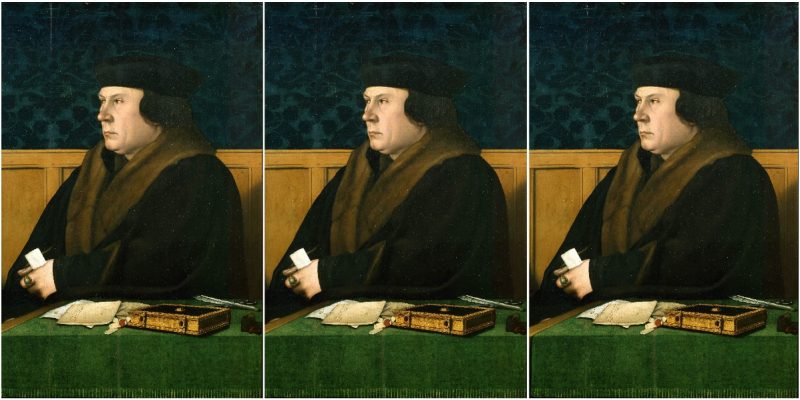Hilary Mantel has blurred the line between fact and fiction, between history and the historical novel. This was already evident in the first two volumes of her trilogy on Thomas Cromwell but her seamless fusing of history and imagination acquires a superlative dimension in this concluding volume that stretches from 1536 to Cromwell’s execution in 1540 by the monarch whom he had so loyally served. A measure of her achievement is the fact that the historian Diarmaid MacCulloch begins his majestic biography of Thomas Cromwell by doffing his cap to Mantel’s inspired achievement in her first two volumes: Wolf Hall and Bring Up the Bodies.

Hilary Mantel
The Mirror and the Light
(Fourth Estate, 2020)
Towards the end of the novel but before Cromwell’s downfall is evident, Mantel has Cromwell say to his son Gregory, “We must roll back time. It will be as if the king blinked, and then lived that first moment again.’’ This could easily serve as a description of what Mantel has achieved. She has, for her readers, rolled back time and then made them live that Cromwellian moment in English history. Mantel immerses herself in the career of Cromwell and the politics that shaped it – how he shaped that politics, and the politics behind his downfall and death. The book is an extended act of creative immersion and retrieval along which Mantel takes her readers. As Cromwell stands next to his king giving his sage but respectful advice, the reader is made to stand next to Cromwell’s elbow listening and watching. We are participants in Cromwell’s words and deeds. Seldom, if ever, has historical reality been presented in such vivid terms. “I always want a story,’’ Cromwell tells his friend Thomas Wyatt, poet and diplomat. Mantel’s story-telling skills are unsurpassed and enviable.
The nature of history and the way history is fashioned together form a running subtext in the novel, expressed sometimes through authorial comments but more often through Cromwell’s ruminations. Mantel writes “…the past is always trickling under the soil, a slow leak you can’t trace.” Elsewhere, she notes how history comes to be written: “History inks the skin: it writes on the hide of sheep long slaughtered and calves, or calves who never breathed; the dead cut away the ground beneath us…”
Death and the dead loom over the narrative. It begins with an execution and ends with another. Cromwell is present at both: in the first one, the execution of Anne Boleyn, beheaded by a sword since she was royal, Cromwell is present, somewhat triumphant, since he brought it about; and in the second one, his own, beheaded by an axe, befitting his station, as the victim. Mantel comments, when Cromwell is trembling in the Tower, awaiting death, “He has lived by the laws he has made and must be content to die by them.” This book is the story of Cromwell’s triumph – his hubris? – and his almost inevitable downfall.
With death there are ghosts. Cromwell is first put in the chamber within the Tower where he had put Anne Boleyn before her execution. He feels she is staring at him from the walls, at her Cremuel (as she always called him). He is moved to the lower level of the Bell Tower, the place where he had lodged Thomas More before his beheading. Cromwell thinks he sees More at the table working on his papers. But the ghost that haunts this book and Cromwell’s life is that of Cardinal Wolsey – his former master, Henry VIII’s principal adviser, Cardinal of York and Lord Chancellor, before his fall from grace over Henry’s divorce from his first wife, Katherine of Aragon. Cromwell thinks he had always been loyal to Wolsey; the latter’s daughter now a nun tells Cromwell to his face that he betrayed her father. Henry thinks Cromwell has never forgotten that he, Henry, had brought about Wolsey’s end. Cromwell’s interrogators think that his loyalty to Wolsey was greater than his loyalty to his monarch. And Cromwell thinks, “I still miss the cardinal of York…I am bested by the Cardinal’s ghost.’’

Site of ancient scaffold at Tower Hill. Photo: Wikimedia Commons/Mariordo (Mario Roberto Duran Ortiz) CC BY SA 3.0
Marriages were a significant part of Cromwell’s life. Not his own but his monarch’s. The manner in which he arranged first the king’s divorce from Katherine in 1533, then supported Henry during his marriage to Anne, and then masterminded Anne’s fall and the king’s marriage to Jane Seymour, resulted in his swift elevation at the court – principal secretary to the king, Master of the Rolls, Lord Privy Seal, Lord Great Chamberlain, vice-regent and then a few months before his death, the Earl of Essex. He was without doubt, between 1531 and 1540, the most powerful man in England, after the king. His detractors – and they were many within the old nobility, most notably the Duke of Norfolk – believed he thought himself more important than the king because the latter was so dependent on him.
The proper name Anne brought both good luck and bad to Cromwell. The marriage of the first of the two Annes – Boleyn with Henry – made Cromwell; the second – Anne of Cleves with Henry – unmade him. Henry’s fourth marriage – to Anne of Cleves – had followed Jane Seymour’s untimely death after the birth of Edward, Henry’s sole male heir. It was Cromwell who had prompted and arranged Henry’s marriage to Anne of Cleaves, the daughter of a powerful Protestant prince, John of Cleves, though it had had the consent of the king and his councillors. Cromwell had been keen on this marital union for political reasons. It was becoming clear to him, Mantel shows, that following Henry’s break from Rome, there was the possibility, right through the second half of the 1530s, of an alliance between the French king, Francis I, and the Spanish king Charles V, who was also the Holy Roman Emperor. Cromwell calculated that Henry needed the support of a powerful German Protestant prince to act as a counterweight to a Franco-Spanish alliance. Many of the German princes, like John of Cleves, had broken from Rome and sided with Martin Luther. Henry did not see himself as a Lutheran but he was anti-Pope.
The marriage proved a disaster from the moment Henry set his eyes on his bride to be. He had only seen a flattering portrait of her that Hans Holbein had made in a bit of a rush. Henry was not quite prepared for what he saw when he rode out from London to meet his future bride in Rochester on New Year’s Day 1540. According to Gregory, Cromwell’s son, who was present when Henry and Anne met, “she flinched’’ and the king was “stricken’’. Henry was by this time a corpulent man with a gammy leg. When Cromwell met his king a day later at Greenwich, the king said, “I find the lady nothing so well as she is spoken of…I had much ado to master myself.’’ His repugnance intensified when he saw her in bed on the wedding night. Later, he confessed to Cromwell that he had been unable to perform. The marriage was never consummated. And for the record, Henry had no children from his two subsequent marriages to two more Katherines – Howard and Parr.

Hilary Mantel/Facebook
If Henry was impotent in his exercise within the marital chamber, he was anything but in the exercise of power. He held Cromwell responsible for his disastrous marriage to Anne of Cleves. Urged by Stephen Gardiner, Bishop of Winchester, and by Norfolk, both enemies of Cromwell, Henry stripped Cromwell of all his official positions, charged him with heresy, imprisoned him in the Tower and had him executed by the axe near Tower Hill in full public display.
It would appear from Mantel’s gripping narrative that Cromwell was principally Henry’s matchmaker. This is a trifle unfair to Cromwell and is perhaps the only drawback of the book, the only point at which Mantel underplays a slice of history to bring greater drama to her novel. Cromwell, as Trevor-Roper observed in an essay on him “overhauled the machinery of government…and he overhauled it so drastically that much of it was not radically altered till the reign of Queen Victoria.’’ Trevor-Roper called him “the most radical of modernisers’’ and remarked that modern history began with Thomas Cromwell. This facet of Cromwell’s work is underplayed in Mantel’s novel. Yet she makes her subject ruminate: “Can you make a new England? You can write a new story. You can write new texts and destroy the old ones, set the torn leaves of Duns Scotus sailing about the quadrangles, and place the gospels in every church. You can write on England, but what was written before keeps showing through…’’ What Mantel brings out is the iron-fisted way in which Cromwell carried out what has come to be called “the English Reformation’’: the bringing down of the great monasteries, the stripping of their altars, seizing of their land and altering the ways people prayed and worshipped. He thus enriched the king’s exchequer, lined his own pocket, bestowed patronage, and set in motion a vibrant land market. He initiated a social revolution. Mantel draws out the revolution in worship by making Cromwell meditate thus: “The English will see God in daylight, not hidden in a cloud of incense; they will hear his words from a minister who faces them, instead of turning his back and muttering in a foreign tongue.’’
But over the achievements of the modernising bureaucrat fell the shadow of an absolutist monarch. Cromwell was a victim of Henry’s whims and suspicions. “We are playing chess in the dark,’’ Cromwell tells Wyatt.
The two most attractive features of the book I have kept till the end. One is, for lack of a better word, texture: the texture of court politics, the texture of clothes and furnishings and most importantly of food. To take just one example of the last item. When Cromwell’s son returns from Rochester to convey news of the disastrous meeting, he is served with “Venison and currant jelly. Pike and horseradish. Plum and raisin.’’ Descriptions of such mouth-watering meals are strewn through the book, almost as asides to evoke the ambience of how the grandees of Henry’s court lived. But it is not just the lives of the grandees that Mantel describes. One of the most powerful sections of the book describe the beginning of the Pilgrimage of Grace – the massive northern uprising against Henry and Cromwell and their attempts to suppress the traditional religion of England. Reading Mantel’s vivid account of how a Michaelmas feast and fair morphed into a popular uprising – not an uncommon occurrence, this shift from carnival to rebellion as students of peasant insurgencies know – I was reminded again and again of that classic Carnival in Romans by Emmanuel le Roy Ladurie. Mantel, like Ladurie, conveys the reality and the feel of a popular uprising.

King Henry VIII Photo: Wikimedia Commons/By After Hans Holbein, Public Domain,
The other is the sheer beauty of Mantel’s prose:
“Father and son [Cromwell and Gregory] ride out together in the evening, the sun a perfect crimson orb above the line of the downs. The sky has become a mirror, against which the sun moves: light without shadow, like the light at the beginning of the world…they move in silence, outlined against silver, tall against the sky; and as the upland fades into a pillowy distance, he [Cromwell] feels himself riding into nowhere, a blank, where only memory stirs.’’
In another place, as Cromwell watches twilight descending from a palace window, Mantel writes, “In the park the trees are marrying the darkness.’’ One can only be left speechless with such writing and the quoted passages are taken at random.
Imprisoned in the tower, Cromwell thinks, “The Duke of Urbino, Federigo di Montefeltro, was asked what it took to rule a state. ‘Èssere umano’, he said: to be human.’’ Neither Henry nor Cromwell reached that standard. But Mantel’s novel, through her evocation of the times, her depiction of character, the construction of the story and the beauty of her prose enhances our humanity. As great writing always does.
Rudrangshu Mukherjee is chancellor and professor of history, Ashoka University.




